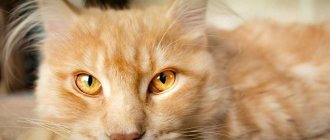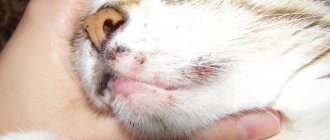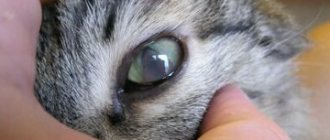Initial activities
MRI, CT (if available);
X-ray of the chest, skull in two projections, cervical spine; IMPORTANT! Every tenth patient with severe TBI also has damage to the cervical spine. Until spinal injury is ruled out, the animal should be managed as having a spinal injury.
Laboratory tests: complete blood count, blood glucose, blood gases and electrolytes, creatinine and blood urea, complete urinalysis; monitoring: general clinical – blood pressure, heart rate, respiratory rate, ECG, blood saturation; neuromonitoring – ICP, EEG, transcranial Doppler echography.
Diagnostic measures
First, the sick animal is examined externally by a doctor.
To identify a concussion in a cat, the doctor finds out the causes of the injury, listens to the owner’s complaints, conducts an external examination and prescribes diagnostic procedures, such as:
- neurological reflex test;
- ophthalmoscopy;
- radiography of the skull bones;
- computed tomography or magnetic resonance imaging;
- blood pressure measurement;
- General and biochemical blood test.
READ DIY cat house from a cardboard box - ideas and instructions with photos
First aid for concussion
If brain damage is suspected, the first thing the owner should do is provide rest to the pet. The cat should be placed in a quiet, darkened room without sources of bright light. It is best to lay the animal on its side.
If the cat is unconscious, you should not revive it yourself. Under no circumstances should you shake or apply ammonia.
If your tongue is retracted, you should take safety measures: place your tongue on its side with a clean napkin and clear the mouth of vomit.
If there is an open head wound, it is necessary to carefully rinse and treat the injury site with disinfectant solutions. Apply dry ice or a cold compress to the impact site.
It is best to transport a sick pet to the clinic on a hard surface. The carrier and lap of the beloved owner are not suitable for this purpose.
To learn how and what to treat a cat’s wounds, watch this video:
Cautious Actions
It should be remembered that after being injured, a cat is in a state of shock and may react hostilely to attempts to provide help. Therefore, you need to act as carefully as possible so as not to worsen the condition of your mustachioed pet.
If the cat is unconscious, it must be transported by first laying it on its side and straightening its body. In this case, it is strictly not recommended to put the pet in a carrier or transport it while holding the animal in your arms. For transportation, a flat surface must be provided. If you notice a concussion in a cat, what should you do in this situation? A veterinarian can tell you about this.
Concussions and contusions of the spinal cord
When a spinal cord injury occurs, conduction along centrifugal and centripetal pathways in one part of the brain weakens or disappears. When the brain is damaged in the cervical thickening, paralysis of the motor pathways of all extremities of the body and internal organs occurs, but the work of the brain and the cyphergram continues to ensure breathing. Damage to the spinal cord between the medulla oblongata and the 4th-6th pairs of cervical nerves is fatal, as paralysis of the respiratory center immediately occurs.
Symptoms.
In case of mild bruises, without damage to the substance of the splint, short-term paresis is noted; in severe cases, the presence of vertebral cracks, ruptures of the meninges and spinal roots, and complications of hemorrhages in the brain are recorded. In this case, there are signs of persistent spinal cord paralysis, decreased deep and superficial sensitivity of the tail and limbs, and prolapse of the rectum. Cats move only with the help of their front limbs, their hind limbs drag. The pelvic part of the body is lowered, the animal is characterized by a sitting position with elongated pelvic limbs. A hump forms at the site of injury.
Diagnosis.
Clinical signs of the disease appear in the animal within the first 5-6 days. With hemorrhage, movement disorders gradually decrease; with appropriate treatment, they completely disappear after 10-15 days. When the meninges are compressed, paraplegia slowly develops and symptoms of movement disorders appear, first on one limb, then on both, and disorders of urination and defecation occur. Preservation of the function of the thoracic limbs in case of pelvic paralysis is determined by a violation of the conductivity of the spinal cord in the anterior part of the lumbar region.
Injury to the sacral spinal cord is characterized by paralysis of the pelvic limbs, tail, sphincters of the rectum and bladder. To make an accurate diagnosis, it is necessary to take x-ray pictures of the injury site and two projections.
Treatment.
The cat is given complete rest, the bleeding is stopped, and cold is applied. Then sedatives and pain-relieving drugs are administered. In the future, thermal procedures and spinal massage are prescribed. Darsonvalization of the spine is very effective in combination with vitamin Bi2 and strychnine (0.1% solution) - 1 ml for paralysis of the pelvic limbs.
For cracks and fractures of the spine, surgery is performed if possible. It should be borne in mind that the treatment is long and requires patience from the doctor and the cat’s owners.
Cats are very dexterous animals, but they do not always manage to avoid falls and bruises. Head injuries and severe concussions in cats are common.
The cause of a concussion in outdoor cats can be a fall from a height, being hit by a car on the road, an awkward jump from a tree, or being hit by a person.
Domestic cats receive head injuries as a result of heavy objects falling on them or hitting a wall if the animal is frightened or does not have time to brake in time. A concussion is accompanied by cerebrovascular accident and sometimes hemorrhage. This process results in disruption (temporary or permanent) of normal brain activity and activity.
First of all, you need to call a veterinarian. An experienced doctor will provide immediate assistance to the animal.
Treatment of concussion in cats, cats and kittens
Specific studies on concussion in cats have not been particularly effective. X-rays or MRIs do not provide complete information about the injury. Therefore, you should contact a qualified and experienced veterinarian who can, based on clinical data, correctly assess the cat’s condition and make a diagnosis.
The doctor first assesses the complexity of the injury and administers medications to the animal that prevent the development of cerebral edema and support the functioning of major vital functions. It should be taken into account that a strong concussion in a cat can disrupt the pet’s usual lifestyle.
Drug treatment consists of prescribing painkillers, vascular and sedatives. If the cat’s condition is severe, then additional medications are prescribed to support cardiac and respiratory activity. In case of nervous or aggressive behavior of the animal, sedatives are prescribed, which should be taken for a long time.
Causes of injury
A cat can get a concussion for a variety of reasons. The most common of these is falling from a great height.
. Despite their agility and ability to always land on their paws, which significantly softens the blow, cats do not know how to circumvent the laws of physics. When falling from a considerable height, they do not die, like other animals, but receive a severe blow, causing a concussion of the brain and spinal cord.
Unfortunately, it is often the person who causes the injury. It can be inflicted accidentally (a blow from a door being opened, a kick while walking) or deliberately. Not all people love these cute animals.
A cat can get a concussion by hitting an obstacle at high speed. This happens when an animal gets scared of something and rushes headlong away. At this moment, there may be an obstacle in its path that the cat, in a panic, does not notice.
Finally, these animals are causing trouble for themselves.
. While playing or exploring the surrounding area, animals can throw a heavy object onto themselves, the impact of which can cause a concussion.
Causes of brain damage
A concussion in cats is a type of traumatic brain injury (TBI) and is characterized by compression of areas of the organ and disruption of blood flow due to a strong collision with the skull. Damage can be closed, when the integrity of the skull is not violated, and open, which is characterized by crushing of the cranial bones and mechanical damage to the brain. Pathology occurs after a blow to the head under the following circumstances:
- falling from a great height;
- auto injury (when a cat was hit by a car);
- accidental trapping of an animal in the door wings;
- a heavy blunt object falling on the cat's head;
- Hitting your head on hard furniture or a wall while playing.
Symptoms in an animal
If the injury occurred in front of the owner, then a characteristic sign of brain damage is the pet losing consciousness. The animal may be unconscious from several seconds to half an hour. Typically, the duration of unconsciousness is influenced by the severity of the injury.
By observing an animal that comes to its senses after being exposed to a mechanical factor, the owner may detect strange behavior. Inadequacy manifests itself in poor spatial orientation, the cat does not recognize familiar people, hisses, behaves aggressively, looks around in fear, and hides.
If the owner did not notice the moment of injury, veterinary experts recommend judging brain damage based on the following symptoms:
- Wounds, bruises, abrasions in the head area indicate that the animal has received trauma. With severe damage, hematomas can be detected.
- Change in color of mucous membranes. Both hyperemia and pallor are observed.
- Pathology of the eye lens in the form of dislocation. In this case, the pupil takes on an unnatural appearance, and different sizes may be observed. A careful examination reveals a trembling of the iris and a spot on the pupil.
- Trembling of the eyeball (nystagmus).
- Lack of reaction to light from dilated pupils.
- Temporary blindness.
- Unsteady, uncertain gait.
- Disorientation in space.
- The animal may rest its head against the wall.
- Drowsy, lethargic state.
- Loss of appetite.
- Vomit.
- Signs of aggression: the cat growls, takes threatening poses, attacks, tries to bite.
- Tremor of the limbs: twitching of the paws, facial muscles, ears. Convulsions.
- Paralysis of limbs.
- Tachycardia.
- Heavy, intermittent breathing.
The intensity of clinical signs is largely determined by the severity of the injury or mechanical impact on the animal. The hypothalamus and brainstem are most often affected. There is a disturbance in the blood circulation of the organ, swelling develops, and intracranial pressure increases. Hemorrhage is also a dangerous consequence of injury.
Symptoms of Concussion in Cats
The most telling symptom of a concussion in cats is a short-term loss of consciousness after injury. Loss of consciousness usually occurs for a couple of minutes, but coma can also occur. In this case, the following pattern is observed: the longer the cat is unconscious, the more severe its condition and consequences.
When the cat regains consciousness, it may not be oriented in space. A more rare symptom may be temporary memory loss. In this case, the animal may not recognize the owner, behave aggressively, and hide in secluded corners. A concussion in a cat is common, but the condition of your pet cannot be ignored.
Strange animal behavior
You should promptly consult a specialist if your cat exhibits the following signs:
- Uneven pupils.
- Lack of pupillary response to light stimulus.
- Rapid and unnatural eye movements.
- A cloudy spot on the pupil, trembling of the iris, an abnormal appearance of the eye associated with displacement of the lens or damage to the ligaments that support it.
- Bruising on the head.
- Too pale or, conversely, too reddened mucous membranes.
- Dizziness (its sign is an unsteady and unsteady gait).
- Headache is a sign of it: the animal rests its head on a hard surface and stands motionless.
- Drowsiness.
- Attacks of aggression.
- Involuntary twitching of paws and facial muscles.
- Paralysis of limbs.
- Short-term loss of hearing or vision.
- Difficulty in orientation.
- Increased heart rate.
- Intermittent breathing accompanied by wheezing.
You need to know that the intensity of the symptoms of a concussion in a cat directly depends on the severity of the injury and the area affected. The mechanism of brain damage during trauma is as follows: the place where the blow was directly received suffers, and after that the brain hits the opposite wall of the skull, also receiving injury. During a concussion, the hypothalamus and brain stem are most vulnerable. Brain hemorrhage is very dangerous
This condition can lead to paralysis of the animal, temporary or permanent, so it is very important to get help as soon as possible. Usually the main symptoms in animals disappear within 2 weeks
In any case, calling a veterinarian will not hurt.
Bed rest
In order for your pet’s recovery to go well and chronic painful disorders in the functioning of the brain not to appear, you need to create conditions for complete rest. Treatment with medications is only fully effective when the animal is in a state of complete rest.
A typical severe concussion in a cat can be cured within 2-3 weeks, provided the doctor's recommendations are followed.
If the concussion was serious, the animal must be monitored by a veterinarian for another 12 months. If necessary, he will adjust the prescribed course of medications and will monitor how quickly and fully brain functions are restored. Now you know how to check for a concussion in your beloved cat.
Every cat or kitten owner should be familiar with the symptoms and first aid rules for a concussion. Timely detection of symptoms and provision of first aid can save your pet’s life. It should be remembered that the behavior of an animal is an indicator of its condition.
First aid at home
If your pet passes out after being hit right in front of you, don’t panic. Take heart and just follow the algorithm, which explains in detail what to do if your cat has a concussion:
Carefully turn your pet onto its side and try to eliminate all irritating factors. To do this, close the curtains tightly, turn off the TV and ask the children to move to another room. Do not use ammonia to revive you - it can burn your mucous membranes.
Examine the victim's mouth. If you find traces of vomit, quickly remove it with a clean cloth or napkin. The sunken tongue needs to be removed. This will help prevent suffocation.
Wash the open wound with warm water and treat it with an antiseptic, remembering to apply a cold compress to the bruised area.
Please note that the removal and repositioning of bone fragments is strictly prohibited.
Count your pulse. If it is missing, begin a rescue operation to restart the stopped heart
To do this, you need to inhale air directly into your nostrils several times or rhythmically squeeze your chest, clasping it with your fingers. Calculate the force of inhalation and pressing so as not to harm your pet. These actions can be alternated by checking your pulse every 2 minutes. Please note that only 20 minutes are allotted for rescue.
Use a flat, hard surface for transport to the veterinary clinic. Instead of a cloth carrier, it is recommended to use a regular cardboard box. It will reduce shaking during movement and protect the animal from sudden hemorrhage.
What are the consequences?
One of the complications from injuries sustained in a pet may be partial paralysis.
Traumatic brain injury is a serious injury and, even if signs are identified promptly and treatment is started, the following complications may develop:
- Hemorrhagic stroke. It is characterized by rupture of a vessel and accumulation of blood in the space between the brain and the skull. May cause blurred vision, gait and memory impairment.
- Loss of vision. Occurs when the visual areas of the brain or nerve are injured.
- Brain swelling in a cat. The condition threatens the life of the animal, since the adult or kitten is subject to impaired oxygen exchange in the lungs and suffocation, which leads to death.
- Paralysis. Occurs when there is dysfunction of the areas of the brain responsible for the innervation of the limbs. May be partial or complete.
- Malignant neoplasms. Trauma can trigger a cell cycle failure, when cells begin to divide and grow abnormally quickly and form a tumor. The condition is dangerous due to the spread of metastases to vital organs, which leads to death.
Traumatic shock
Traumatic shock is considered one of the most dangerous conditions in cats. It is the most common cause of death in animals.
Signs of traumatic shock
Shock in a cat can be determined by the following signs:
- change in heartbeat (increased or slowed down);
- breathing became faster;
- gums become pale (may become completely white);
- body temperature has decreased.
If you find no external damage to your pet, shock may be caused by bleeding or internal damage.
First aid for a cat with traumatic shock
An injured cat needs immediate help. To begin, place the cat on its side on a pre-spread towel (or diaper). If necessary, open its airways: place your palm under the animal's head so that the index finger and thumb are above its upper fangs. Then tilt your head lying on your palm so that the animal’s nose is directed upward. Squeeze your fingers very gently, after which the cat’s mouth will open slightly. Gently pull your pet's tongue with your other hand, thereby opening the airway.
Place a rolled-up towel or small pillow under the cat's hind legs and hips - the back of the cat's body should be elevated.
Carefully examine the animal, if you find external bleeding, stop it.
Treatment
It would be ideal if a dog’s concussion and its treatment are monitored by a veterinary specialist throughout the entire therapeutic course. The veterinarian assesses the animal’s condition and prescribes treatment based on personal observations and medical history from the owner of the four-legged patient. During the course, medications and their dosages can be replaced by one another, depending on the body’s response to the medication.
For a complete diagnosis it is recommended:
- take an X-ray of the skull to rule out fractures or splits of the cranial bones, as well as displacement of the cervical vertebrae;
- conduct a computed tomography scan to assess the extent of brain damage;
- Additionally, obtain advice from a veterinary ophthalmologist and neurologist.
Medications
Calcium chloride 10% Twice daily intravenously for 1-2 weeks, depending on the severity of the condition and the risk of developing cerebral edema. Manitol (Mannitol) 15% Administer slowly by drip (from 20 minutes to half an hour) at a rate of 0.25-2 g/kg daily for as many days as the situation requires, but at least 3 days. Furosemide 5% (diuretic) Intramuscularly from 0.5 to 2 ml 1-2 times a day for 3-5 days depending on the condition
Use caution if you have kidney problems.
Mexidol-Vet 2.5% Intravenously or into the muscle, 0.5 ml/kg during the first week, and then 0.25 ml/kg for another 2-3 weeks. Cerebrolysin 1 to 5 ml intramuscularly 1-2 times a day for at least a month. Piracetam Intramuscularly from 1 to 5 ml 1-2 times a day, depending on the severity of the condition. The course is at least 14 days. Cinnarizine ½ tablet
twice a day for a course of 1 month. Monitor the dynamics, the dose can be increased to 1 tablet in special conditions. Actovegin Intramuscularly, 1 ml 1-2 times a day for 1-3 weeks. The first week - daily, then every other day.
Papaverine Subcutaneously or intramuscularly 1-3 mg/kg twice a day or as required. Travmatin Subcutaneously or intramuscularly, 0.1 ml/kg, but not more than 4 ml at a time. Symptomatically. Baralgin 0.1 ml/kg intramuscularly in the morning and evening or on demand when the dog is clearly in pain.
Sereniya Subcutaneously at a dose of 0.5 ml/5 kg once a day and no longer than 5 days. Cerucal Intramuscularly (rarely subcutaneously) 0.2-0.4 mg/kg up to 4 times a day. Doesn't always help, because... There is individual sensitivity to vomiting of central action. Ondasetron 0.5 mg/kg intramuscularly or intravenously no more than 2 times a day for 3-5 days.
| Lauretin S | Subcutaneously or intramuscularly by slow injection |
| Sulfocamphocaine | No more than 2 ml at a time per animal, depending on the size and severity of the condition. Subcutaneously, intramuscularly or slowly intravenously. Symptomatically. |
| Cordiamine | Dose: 0.2-0.5 ml subcutaneously per individual if necessary. |
| Caffeine-vet 20% | 0.2-0.5 ml subcutaneously per animal symptomatically if necessary. |
| Vetspokoin | Orally (into the mouth) 1 ml/10 kg for small dogs and 1 ml/20 ml for large dogs twice a day for 15 days. |
| Clonazepam | 0.06-026 mg/kg orally twice daily. It should not be abused, it is addictive. Slow “acceleration” of action. |
| Seduxen | 1.5 to 3 mg orally or intramuscularly symptomatically to calm very aggressive dogs. |
| Spitomin | Suitable for long courses - from 4 to 6 weeks. The dosage is selected individually, starting from 0.6 mg/kg (maximum 1 mg/kg) twice a day. |
| Valium (diazepam) | 0.017-0.07 mg/kg orally up to 3 times a day. Do not take for a long time, it provokes physical addiction. Aggressive dogs are not allowed, because... blocks inhibition reflexes, the dog may bite unconsciously. |
| Vitam | Intramuscularly or subcutaneously from 1 to 5 ml 1 time in 3 days for 2 weeks or daily for 1 week - depends on the general condition and appetite. |
| Gamavit | Subcutaneously or into the thigh at a dose of 0.1-0.15 ml/kg once a day every other day for 2-4 weeks. |
| Glycopene | Orally 0.1-0.15 mg/kg (1/2-2 tablets) once a day for a week, daily or every other day. |
| Neurobex | ½ tablet 1 r./day for 1 month. |
Animal treatment
Therapeutic measures are aimed primarily at reducing cerebral edema. For this purpose, drugs such as Hypothiazide, Indap, Indapamide are used.
For the same purpose, the veterinarian may prescribe diuretic drugs, for example Furosemide, Diacarb, Veroshpiron, and potassium supplements.
Some of these drugs also have a decongestant effect. Diakarb reduces intracranial pressure, relieves swelling of the brain, and has a mild sedative effect. The administration of methenamine with caffeine also reduces the permeability of the blood vessels of the damaged organ.
The animal is required to be prescribed painkillers: analgin, baralgin, no-spa. Cardiac medications are used to treat the disease: camphor, cardamine, caffeine.
A good therapeutic effect is achieved by using nootropic drugs: Piracetam, Glycine, Cerebrolysin, Cytoflavin. Neurotropic drugs improve the nutrition of nerve cells and metabolism in brain tissue.
According to indications, a veterinarian may prescribe antiemetic drugs such as Cerucal, Metoclopramide. For severe autonomic disorders, No-shpa and Eufillin, which have a pronounced antispasmodic effect, are prescribed.
An animal with a concussion must be prescribed sedatives: Fitex, Xylazine, Fospasim. Preparations based on medicinal herbs, for example, motherwort, are also used.
We recommend reading about rabies in dogs and cats. You will learn about the course of the disease in animals, forms of rabies, diagnosis, treatment. And here is more information about how to treat a cat’s wound.
About the signs of pathology
First of all, you need to understand that a concussion is not a disease, but a consequence of an injury. If left untreated, complications will arise in the form of chronic diseases that undermine the pet’s health. The owner must be aware that any head injury, sometimes minor, can lead to a concussion. A cup that accidentally falls on an animal's head or a blow from a sharply opening door can provoke this pathology. After this, your animal may appear normal. And all because the milder the injury, the more difficult it is to notice with the naked eye the deterioration of the animal’s condition and, even more so, disruptions in brain function. After all, after minor injuries, a cat eats well and reacts adequately to the situation. But after a few months she may experience seizures, convulsions, and heart ailments. By that time, the owner has already forgotten about the injury.
That is why it is so important to show the patient to the doctor after it, even if the injury is mild. When it is strong, a short-term loss of consciousness may be a symptom of a concussion.
The animal comes to its senses after a few seconds or minutes. The longer the fainting state lasts, the more serious the injury. When the injured animal comes to its senses, it looks stunned, not understanding what happened to it. Sometimes short-term memory loss may occur. A cat does not recognize its owner, hisses at him, and hides in hard-to-reach places.
It often happens that animals are walking on the street and get injured there, and the owner is not present. You can suspect something is wrong based on the following signs: bruises, hematomas, bruises on the head and neck, pale mucous membranes. Problems with the head are clearly signaled by the animal's eyes. We are talking about an unnatural shape of the pupil, that is, a dislocation of the lens. A pale spot may appear on the pupil, and the iris may tremble. The eyes of cats after severe head injuries look unnatural because the lens capsule is displaced. Also, the visual apparatus can respond to injury with nystagmus - rapid movement of the eyeballs. Unsteady gait, twitching or paralysis of facial muscles, convulsions, loss of orientation and hearing, wheezing, rapid pulse are typical symptoms of severe head injuries in animals. Their headaches may manifest themselves by leaning against walls or corners and freezing in this position.
Signs of a concussion depend on the severity and location of the impact. Brain tissue is damaged not only in the place where the blow was struck, but also on the opposite side.
What happens when you hit your head?
When an animal experiences a concussion, the functioning of the central nervous system and musculoskeletal system is disrupted for some time. Most often, cats suffer from mild concussions.
As you know, a strong concussion in a cat is the result of damage due to an impact. If proper treatment of a brain injury is not started in time, this is fraught with complications that can develop into chronic diseases that can worsen the pet’s health and limit its physical activity.
Every cat owner should be clearly aware that even a minor injury to the head can result in a concussion. Moreover, the more minor the damage, the more difficult it is to determine disorders in brain activity at home.
The cat may behave absolutely adequately, not suffer from a lack of appetite, and also not show signs of impaired motor functions. However, after some time, symptoms such as seizures, heart problems, and behavioral disorders may suddenly appear. This indicates a hidden brain injury.
Therefore, there is no need to wait for any symptoms of a concussion to appear after the impact - you need to take your pet to the veterinarian. Moreover, for emergencies there is a 24-hour veterinary clinic. It is better for this to be a false alarm than for the appearance of chronic diseases as a result of delayed treatment or lack of treatment at all.
Treatment
If your dog has a bad fall or accident and exhibits any of the above signs, it is very likely that he has a concussion. Now that you have identified the problem, you need to treat your concussion as quickly as possible. Just like humans, dogs also have a treatment protocol.
First, you need to calm your dog so that he doesn't get too excited. If she is scared or anxious, you will have a hard time determining whether she actually has a traumatic brain injury.
In some cases, your dog may not even be injured. You won't know until you calm him down and make sure he's okay. If there is a visible wound you should take your dog to the vet immediately. Even if there is no head injury, if your dog is showing symptoms, take him to the vet as well.
Since your dog may not report pain or confusion, in the event of a head injury, it's best to play it safe and take him to the hospital.
When it arrives, the veterinarian will run a series of tests on your dog. Basically, the veterinarian will draw blood and ensure that all of your dog's organs are working properly, eliminating the possibility of shock, before proceeding.
The shock is extremely severe and results in long-term damage and death. If you notice your dog is in shock, raise his head and watch his breathing in case he needs to perform CPR.
How to perform CPR on a dog:
- Lay the dog on its side on a flat surface.
- Place your hand on most of the dog's chest.
- With your arms secured, squeeze your dog's chest to a quarter of its width at a steady rate of 80 compressions per minute.
- Continue CPR until your dog is conscious, breathing on his own, or a trained veterinarian or staff can provide compressions.
Signs of shock are:
- Limited mental performance or activity
- blue gums
- irregular heartbeat
- low temperature
- rapid breathing
- shallow pulse
- convulsions
After ruling out shock and evaluating the heart and lungs, your veterinarian may give your dog oxygen and fluid infusions to prevent nausea and relieve some symptoms.
Your dog may also be prescribed some anti-inflammatory medications to reduce and prevent brain inflammation and to make your dog more comfortable.
Certain neurological tests may be performed to better assess the severity of a concussion. Some severe cases require surgery to correct brain bleeding or other internal injuries that accompany a concussion.
Like people who suffer a head injury, your dog will likely be kept overnight for observation. In severe cases, your dog may remain in the hospital for several days.
This time allows the veterinarian to determine how severe the brain swelling may be, rule out any type of internal bleeding, and closely monitor any symptoms that arise.
It also prevents secondary injuries, which can be more traumatic and cause more serious long-term consequences than the initial head injury. Other than these few steps, there really isn't much that can be done for a head injury. Observation and rest are key aspects of the healing process.
Treatment: which methods are effective?
One of the unpleasant consequences of injury in pets is a concussion.
The danger of damage to an organ of the central nervous system is that the pathology has long-term consequences and can manifest itself after years.
In this regard, the owner of a furry fidget should be attentive to even a minor injury, have an idea of the symptoms of the disease and provide the necessary assistance in a timely manner.
A domestic cat can get brain damage in a variety of situations. The most common cause of the disease is collisions with road vehicles, including bicycles.
Falling from a height or incorrect landing when jumping from a tree is a common cause of concussion in free-ranging cats. With the onset of the summer season, cases of animals falling out of windows and balconies are becoming more frequent.
Stray cats can become victims of hooligans and cruel treatment of people. Blows to the head are one of the common causes of pathology. Heavy objects falling on your pet's head and accidental hits against a wall are also common causes of brain damage.
The owner of the animal should not ignore even a minor injury in this area. The danger with a concussion is that after a few months, your pet may experience severe symptoms such as seizures, convulsions, neurological problems and other health problems.
One of the unpleasant consequences of injury in pets is a concussion. The danger of damage to an organ of the central nervous system is that the pathology has long-term consequences and can manifest itself after years. In this regard, the owner of a furry fidget should be attentive to even a minor injury, have an idea of the symptoms of the disease and provide the necessary assistance in a timely manner.
Read in this article
To avoid severe consequences, the following treatment methods are used for traumatic brain injury in cats:
- Taking medications: To prevent edema, diuretics are prescribed - “Hypothiazide”, “Urotropin”, “Furosemide”, “Veroshpiron”.
- To maintain the functioning of the heart, injections should be made with drugs such as “Caffeine benzoate sodium 20%”, camphor solution 20%.
- Antishock medications - Prednisolone, Travmatin, Dexamethasone.
- Metoclopramide and Cerucal are effective in suppressing the gag reflex.
Forecast
The prognosis depends on the severity of the disease, the area of injury and its degree. Coma that lasts more than 48 hours or a progressive deterioration of the condition is considered to have a poor prognosis.
Cats who have suffered a TBI should be regularly examined by a neurologist to monitor the dynamics and correct the prescribed therapy. Some patients recover quite slowly and the extent of their recovery cannot be predicted
Neurological signs can persist in cats for almost months and it is important to be patient, follow all recommendations of a veterinarian, provide a high-quality diet and good care
Read reviews about our veterinary center. Call the number and schedule a consultation right now or request a call back. (c) Veterinary center for the treatment and rehabilitation of animals “Zoostatus”. Varshavskoe highway, 125 building 1.
First signs
A dog that has suffered a concussion may behave normally with a minor injury. With more severe injuries, the following signs and symptoms of a dog concussion occur:
- Lethargy, inert behavior, apathy. These are usually the first signs of a mild concussion.
- Headache, due to which the animal either tries to keep its head unnaturally straight and still, or shakes it vigorously.
- Impaired coordination of movements.
- Nausea, vomiting.
- Lack of appetite.
- The dog sleeps a lot, tries to hide from everyone, even from its owners.
- Loss of consciousness, unexpected fainting. Loss of consciousness is especially dangerous if the animal is constantly vomiting - it can choke on its own vomit.
- Inappropriate behavior up to and including attacks on its owner and strangers.
- In severe cases, breathing and heartbeat disturbances occur, and the pupils are dilated over the entire eye and do not respond.











